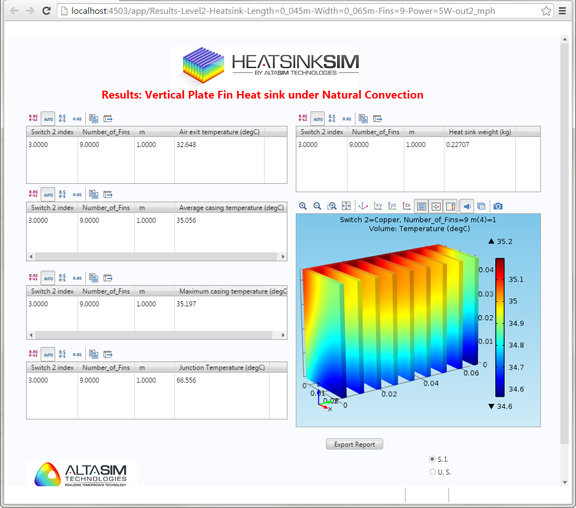The Implications of Simulation’s App-ification

Latest News
April 26, 2016
 The HeatSinkSim app, developed AltaSim, runs on COMSOL Multiphysics simulation software. It’s distributed through AweSim, an offshoot of the Ohio Supercomputing Center’s Blue Collar Computing initiative (image courtesy of AltaSim).
The HeatSinkSim app, developed AltaSim, runs on COMSOL Multiphysics simulation software. It’s distributed through AweSim, an offshoot of the Ohio Supercomputing Center’s Blue Collar Computing initiative (image courtesy of AltaSim). With a simplified user interface, the HeatSinkSim app users do not need to learn to use COMSOL Multiphysics software, even though the app uses COMSOL software as its solver in the background (image courtesy of AltaSim).
With a simplified user interface, the HeatSinkSim app users do not need to learn to use COMSOL Multiphysics software, even though the app uses COMSOL software as its solver in the background (image courtesy of AltaSim).Nestled between York Golf Club and Spring Hallow in the city of Worthington, Ohio, AltaSim established itself as a simulation consultant specializing in the use of COMSOL Multiphysics suite. But the company is also testing the waters in the emerging simulation app market, an offshoot of the industry’s desire to make simulation much more accessible to a wider user base.
Traditionally, the use of simulation revolves around general-purpose simulation software packages. The level of expertise required by this approach limits the pool of candidates who can use the technology. But the app-ification of simulation—the movement to encapsulate repeatable simulation tasks as simple, template-driven apps—broadens the playing field. It also leave room for simulation app developers—a new type of vendors.
AltaSim’s HeatSinkSim examplifies this trend. It also illustrates the complex relationships and partnerships that must exist to support the new usage paradigm.
To begin, AltaSim developed HeatSinkSim. In the creators’ own words, the app analyzes heat transfer “using conduction, convection, and radiation. Two levels of analyses are available: Level 1 analyzes a range of heat sink designs to identify optimum heat sink designs; Level 2 provides a detailed analysis of the optimum heat sink design and is automatically recommended when predicted temperatures approach component operating limits.”
HeatSinkSim is an app—a repeatable simulation operation—built to run on COMSOL Multiphysics. In other words, when a user pluck in the input parameters, the app uses COMSOL software to compute the answer in the background. This allows novice users with limited multiphysics simulation software expertise to bypass the need learn COMSOL software to set up the problem correctly.
COMSOL, the company behind the popular COMSOL Multiphysics software, also encourages the app-ification with the release of its COMSOL Server, which functions as the host for simulation apps.
HeatSinkSim app is distributed through AweSim, a public-private partnership created by the Ohio Supercomputer Center’s (OSC) Blue Collar Computing initiative. AweSim’s director Alan Chalker said, “Simulation-driven design replaces physical product prototyping with less expensive computer simulations, reducing the time to take products to market, while improving quality and cutting costs. Smaller manufacturers largely are missing out on this advantage, because they cannot afford to leverage such solutions. We aim to level the playing field, giving the smaller companies equal access.”
Note: For more, listen to a recent DE roundtable chat with AweSim’s Alan Chalker, now available online here.
The shift to simulation apps is one way to level the playing field, both in the cost and the skill required to use simulation. But the simulation app market is still in its infancy; therefore, it’s difficult to gauge its commercial strength.
At the present, there’s no established pricing or licensing norm for app-style simulation usage. So the app developer, the app distributor, the general-purpose simulation software maker, and the hardware infrastructure provider must negotiate an economically viable revenue-sharing scheme among themselves.
At the same time, identifying app-ification opportunities and pricing the app fairly remain a challenge for app developers. A simulation app that’s expected to draw high-volume usage (for example, a cell-phone drop-test app) may be sold at a relatively low cost. On the other hand, an app to simulate a rare but unavoidable crisis (for example, a nuclear reactor meltdown simulator) needs a different pricing model.
Jeff Crompton, AltaSim’s principle consultant, said, “HeatSinkSim has just finished beta-testing, so we currently have no numbers on sales or usage.” He clarified that the app can be installed in a desktop PC, run remotely through a browser, or run on remote hardware. It’s available for purchase, short term lease, or pay-per-use licensing.
Subscribe to our FREE magazine, FREE email newsletters or both!
Latest News
About the Author
Kenneth Wong is Digital Engineering’s resident blogger and senior editor. Email him at [email protected] or share your thoughts on this article at digitaleng.news/facebook.
Follow DE





